Implementation of Activity-based Management in Dulux Paint Company
VerifiedAdded on 2023/01/19
|16
|3461
|63
AI Summary
This document discusses the implementation of activity-based management in Dulux Paint Company, including issues related to performance evaluation, supply chain management, quality management, and environmental sustainability.
Contribute Materials
Your contribution can guide someone’s learning journey. Share your
documents today.
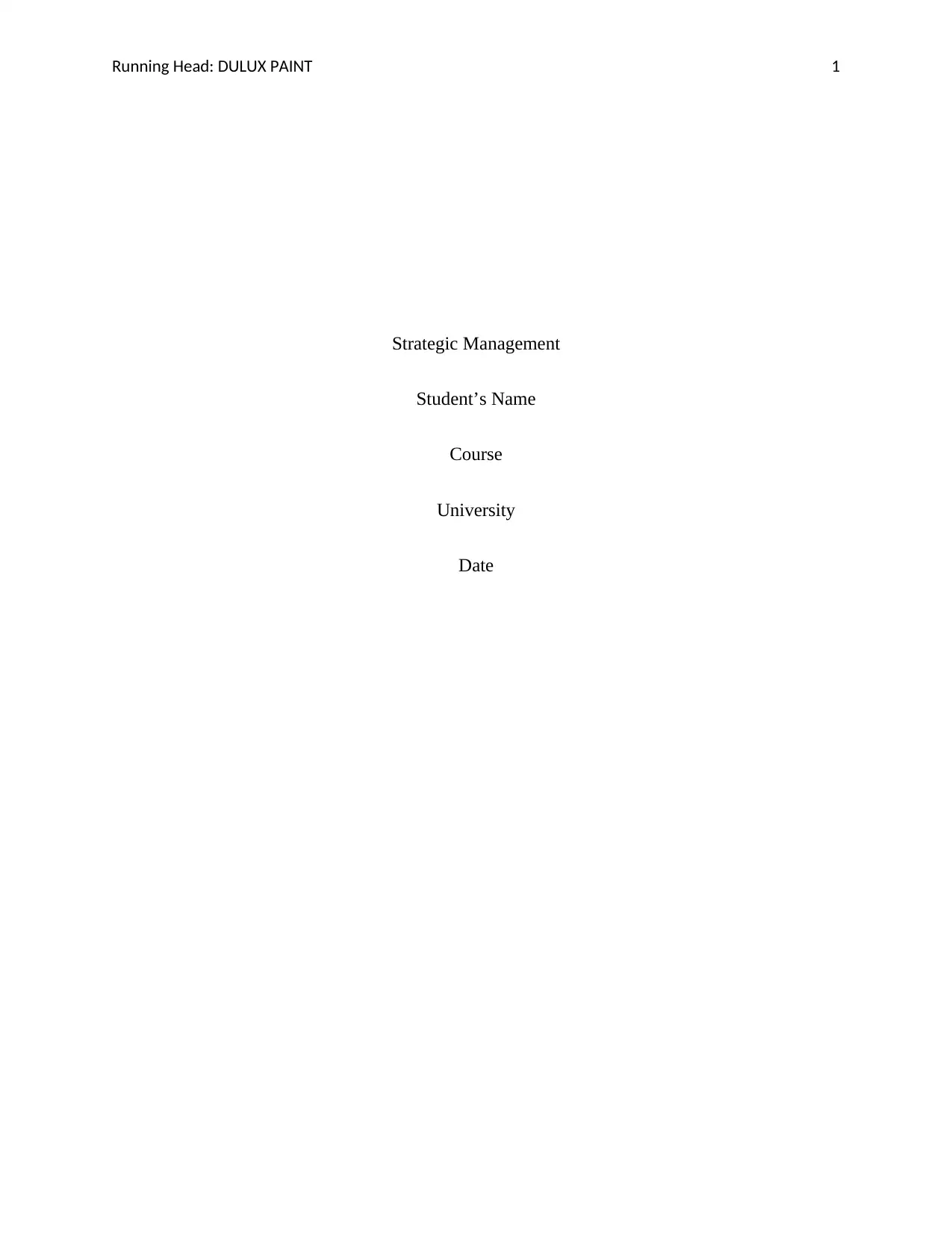
Running Head: DULUX PAINT 1
Strategic Management
Student’s Name
Course
University
Date
Strategic Management
Student’s Name
Course
University
Date
Secure Best Marks with AI Grader
Need help grading? Try our AI Grader for instant feedback on your assignments.
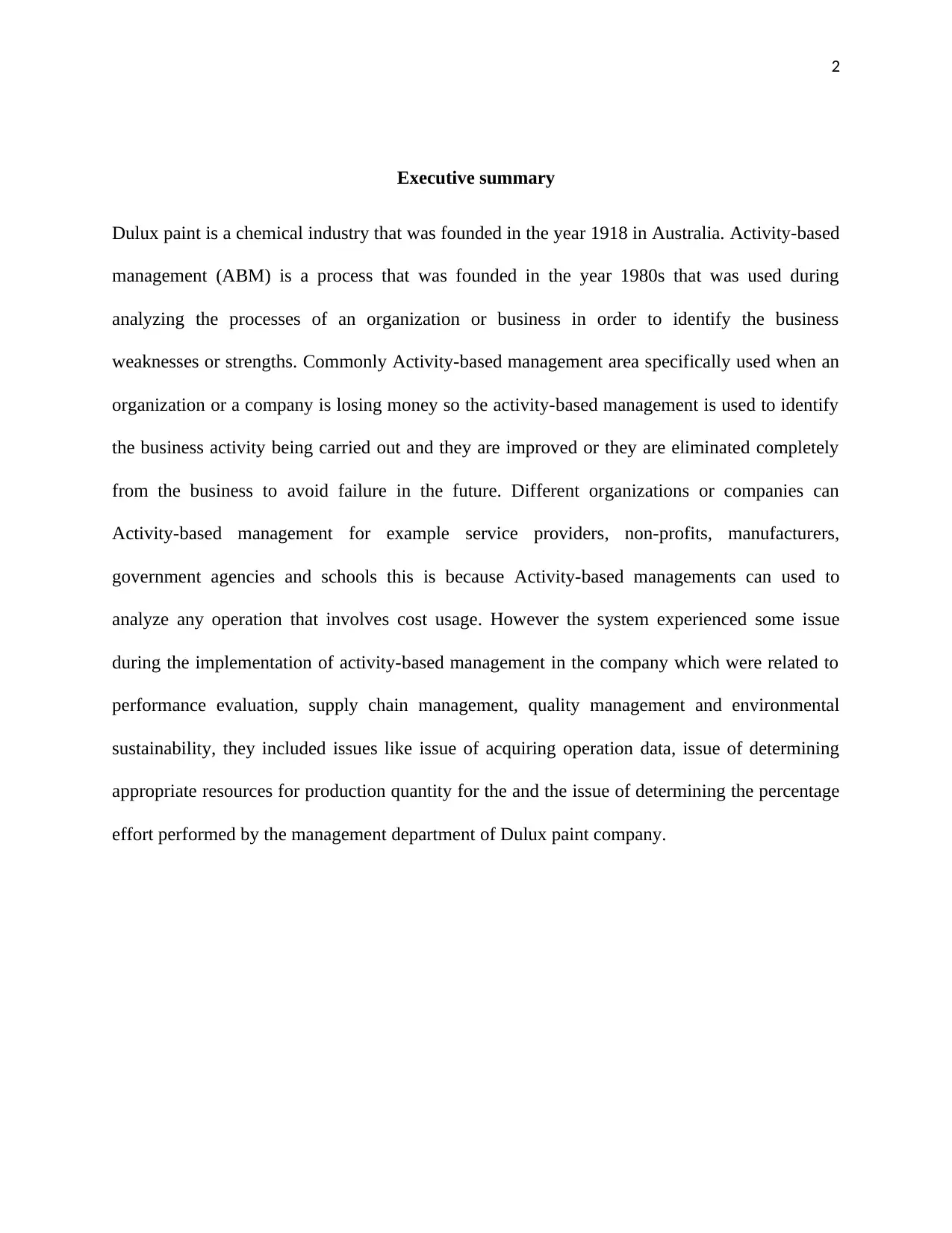
2
Executive summary
Dulux paint is a chemical industry that was founded in the year 1918 in Australia. Activity-based
management (ABM) is a process that was founded in the year 1980s that was used during
analyzing the processes of an organization or business in order to identify the business
weaknesses or strengths. Commonly Activity-based management area specifically used when an
organization or a company is losing money so the activity-based management is used to identify
the business activity being carried out and they are improved or they are eliminated completely
from the business to avoid failure in the future. Different organizations or companies can
Activity-based management for example service providers, non-profits, manufacturers,
government agencies and schools this is because Activity-based managements can used to
analyze any operation that involves cost usage. However the system experienced some issue
during the implementation of activity-based management in the company which were related to
performance evaluation, supply chain management, quality management and environmental
sustainability, they included issues like issue of acquiring operation data, issue of determining
appropriate resources for production quantity for the and the issue of determining the percentage
effort performed by the management department of Dulux paint company.
Executive summary
Dulux paint is a chemical industry that was founded in the year 1918 in Australia. Activity-based
management (ABM) is a process that was founded in the year 1980s that was used during
analyzing the processes of an organization or business in order to identify the business
weaknesses or strengths. Commonly Activity-based management area specifically used when an
organization or a company is losing money so the activity-based management is used to identify
the business activity being carried out and they are improved or they are eliminated completely
from the business to avoid failure in the future. Different organizations or companies can
Activity-based management for example service providers, non-profits, manufacturers,
government agencies and schools this is because Activity-based managements can used to
analyze any operation that involves cost usage. However the system experienced some issue
during the implementation of activity-based management in the company which were related to
performance evaluation, supply chain management, quality management and environmental
sustainability, they included issues like issue of acquiring operation data, issue of determining
appropriate resources for production quantity for the and the issue of determining the percentage
effort performed by the management department of Dulux paint company.

3
Table of Contents
Introduction.............................................................................................................................................4
Brief discussion of nature of activity based management..............................................................5
Steps followed in implementation of activity based management................................................6
Issues related to the implementation of activity based management in Dulux Paint
Company in the context of satisfy organization’s stakeholders and ensuring long-term
viability and/or sustainability of the organization...........................................................................7
Sustainability of the company............................................................................................................12
Environmental sustainability.............................................................................................................13
Conclusion..............................................................................................................................................14
References...............................................................................................................................................15
Table of Contents
Introduction.............................................................................................................................................4
Brief discussion of nature of activity based management..............................................................5
Steps followed in implementation of activity based management................................................6
Issues related to the implementation of activity based management in Dulux Paint
Company in the context of satisfy organization’s stakeholders and ensuring long-term
viability and/or sustainability of the organization...........................................................................7
Sustainability of the company............................................................................................................12
Environmental sustainability.............................................................................................................13
Conclusion..............................................................................................................................................14
References...............................................................................................................................................15
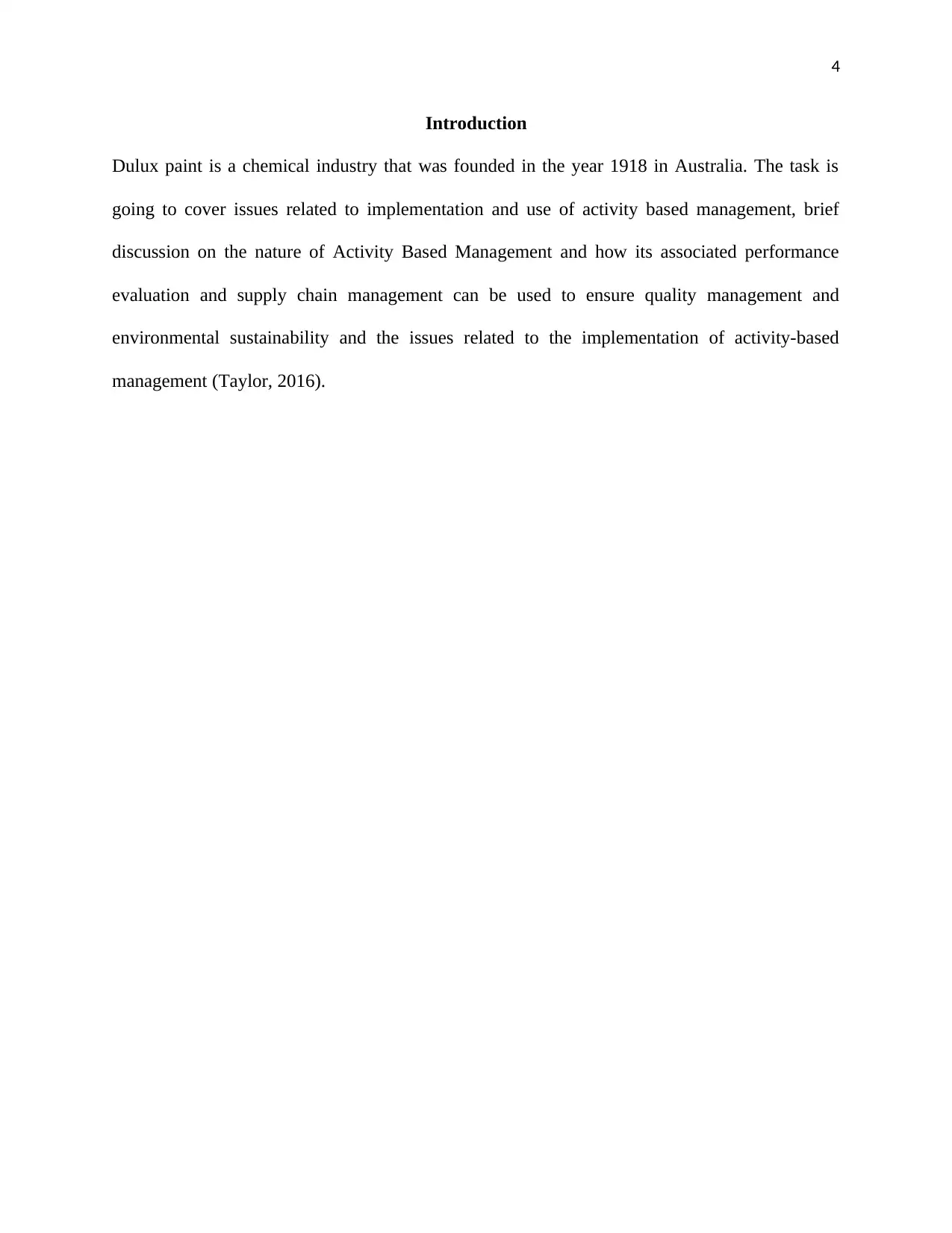
4
Introduction
Dulux paint is a chemical industry that was founded in the year 1918 in Australia. The task is
going to cover issues related to implementation and use of activity based management, brief
discussion on the nature of Activity Based Management and how its associated performance
evaluation and supply chain management can be used to ensure quality management and
environmental sustainability and the issues related to the implementation of activity-based
management (Taylor, 2016).
Introduction
Dulux paint is a chemical industry that was founded in the year 1918 in Australia. The task is
going to cover issues related to implementation and use of activity based management, brief
discussion on the nature of Activity Based Management and how its associated performance
evaluation and supply chain management can be used to ensure quality management and
environmental sustainability and the issues related to the implementation of activity-based
management (Taylor, 2016).
Secure Best Marks with AI Grader
Need help grading? Try our AI Grader for instant feedback on your assignments.
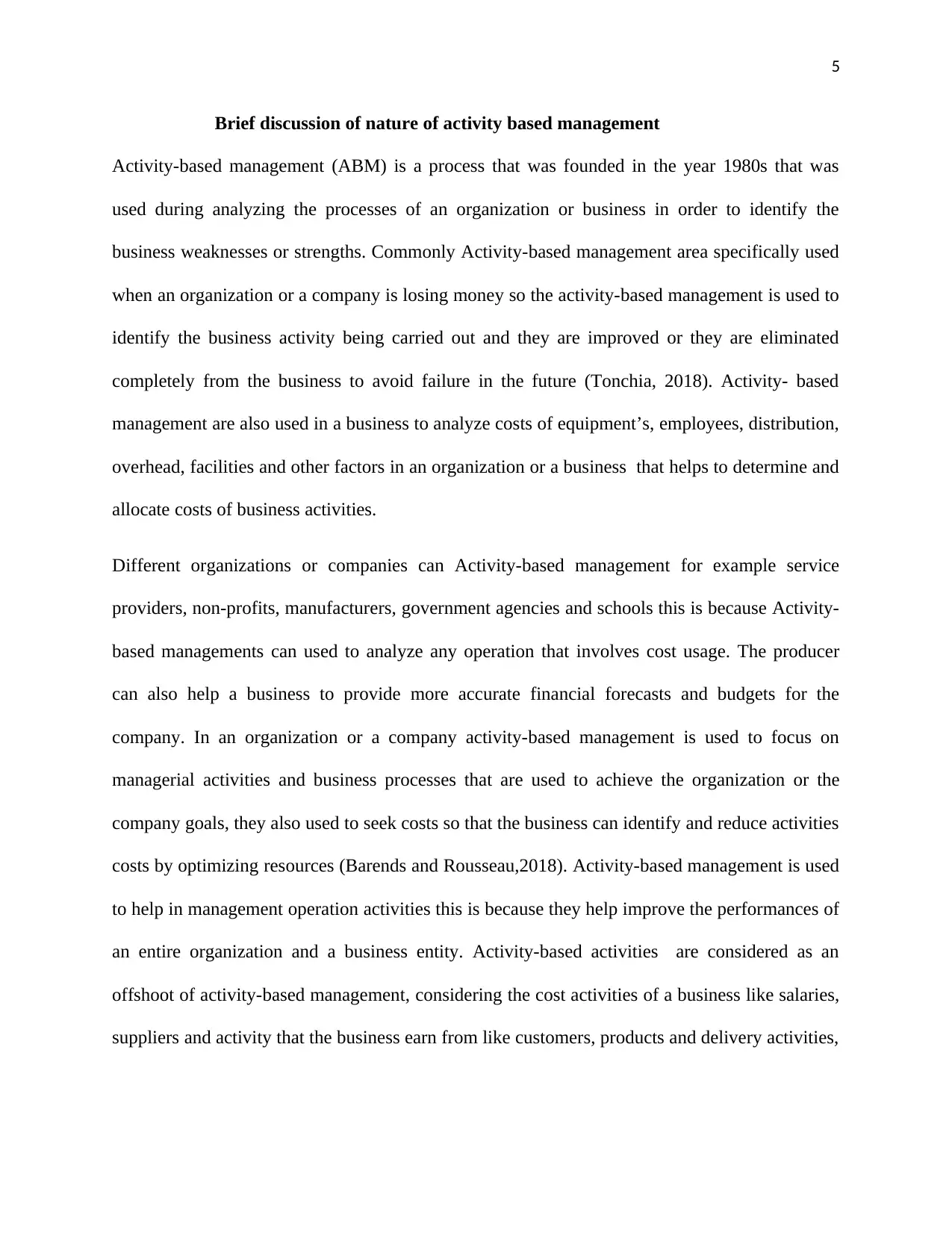
5
Brief discussion of nature of activity based management
Activity-based management (ABM) is a process that was founded in the year 1980s that was
used during analyzing the processes of an organization or business in order to identify the
business weaknesses or strengths. Commonly Activity-based management area specifically used
when an organization or a company is losing money so the activity-based management is used to
identify the business activity being carried out and they are improved or they are eliminated
completely from the business to avoid failure in the future (Tonchia, 2018). Activity- based
management are also used in a business to analyze costs of equipment’s, employees, distribution,
overhead, facilities and other factors in an organization or a business that helps to determine and
allocate costs of business activities.
Different organizations or companies can Activity-based management for example service
providers, non-profits, manufacturers, government agencies and schools this is because Activity-
based managements can used to analyze any operation that involves cost usage. The producer
can also help a business to provide more accurate financial forecasts and budgets for the
company. In an organization or a company activity-based management is used to focus on
managerial activities and business processes that are used to achieve the organization or the
company goals, they also used to seek costs so that the business can identify and reduce activities
costs by optimizing resources (Barends and Rousseau,2018). Activity-based management is used
to help in management operation activities this is because they help improve the performances of
an entire organization and a business entity. Activity-based activities are considered as an
offshoot of activity-based management, considering the cost activities of a business like salaries,
suppliers and activity that the business earn from like customers, products and delivery activities,
Brief discussion of nature of activity based management
Activity-based management (ABM) is a process that was founded in the year 1980s that was
used during analyzing the processes of an organization or business in order to identify the
business weaknesses or strengths. Commonly Activity-based management area specifically used
when an organization or a company is losing money so the activity-based management is used to
identify the business activity being carried out and they are improved or they are eliminated
completely from the business to avoid failure in the future (Tonchia, 2018). Activity- based
management are also used in a business to analyze costs of equipment’s, employees, distribution,
overhead, facilities and other factors in an organization or a business that helps to determine and
allocate costs of business activities.
Different organizations or companies can Activity-based management for example service
providers, non-profits, manufacturers, government agencies and schools this is because Activity-
based managements can used to analyze any operation that involves cost usage. The producer
can also help a business to provide more accurate financial forecasts and budgets for the
company. In an organization or a company activity-based management is used to focus on
managerial activities and business processes that are used to achieve the organization or the
company goals, they also used to seek costs so that the business can identify and reduce activities
costs by optimizing resources (Barends and Rousseau,2018). Activity-based management is used
to help in management operation activities this is because they help improve the performances of
an entire organization and a business entity. Activity-based activities are considered as an
offshoot of activity-based management, considering the cost activities of a business like salaries,
suppliers and activity that the business earn from like customers, products and delivery activities,
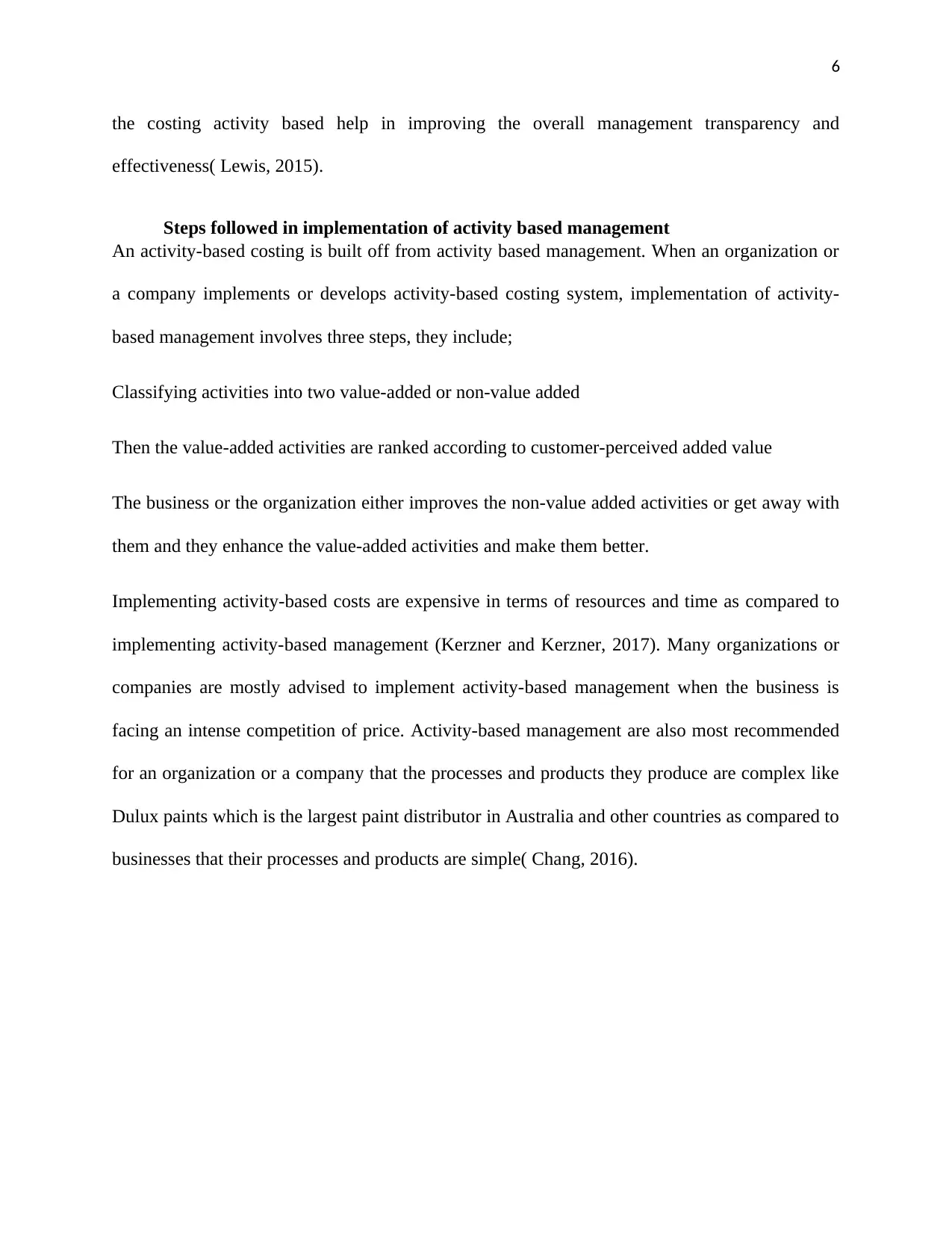
6
the costing activity based help in improving the overall management transparency and
effectiveness( Lewis, 2015).
Steps followed in implementation of activity based management
An activity-based costing is built off from activity based management. When an organization or
a company implements or develops activity-based costing system, implementation of activity-
based management involves three steps, they include;
Classifying activities into two value-added or non-value added
Then the value-added activities are ranked according to customer-perceived added value
The business or the organization either improves the non-value added activities or get away with
them and they enhance the value-added activities and make them better.
Implementing activity-based costs are expensive in terms of resources and time as compared to
implementing activity-based management (Kerzner and Kerzner, 2017). Many organizations or
companies are mostly advised to implement activity-based management when the business is
facing an intense competition of price. Activity-based management are also most recommended
for an organization or a company that the processes and products they produce are complex like
Dulux paints which is the largest paint distributor in Australia and other countries as compared to
businesses that their processes and products are simple( Chang, 2016).
the costing activity based help in improving the overall management transparency and
effectiveness( Lewis, 2015).
Steps followed in implementation of activity based management
An activity-based costing is built off from activity based management. When an organization or
a company implements or develops activity-based costing system, implementation of activity-
based management involves three steps, they include;
Classifying activities into two value-added or non-value added
Then the value-added activities are ranked according to customer-perceived added value
The business or the organization either improves the non-value added activities or get away with
them and they enhance the value-added activities and make them better.
Implementing activity-based costs are expensive in terms of resources and time as compared to
implementing activity-based management (Kerzner and Kerzner, 2017). Many organizations or
companies are mostly advised to implement activity-based management when the business is
facing an intense competition of price. Activity-based management are also most recommended
for an organization or a company that the processes and products they produce are complex like
Dulux paints which is the largest paint distributor in Australia and other countries as compared to
businesses that their processes and products are simple( Chang, 2016).
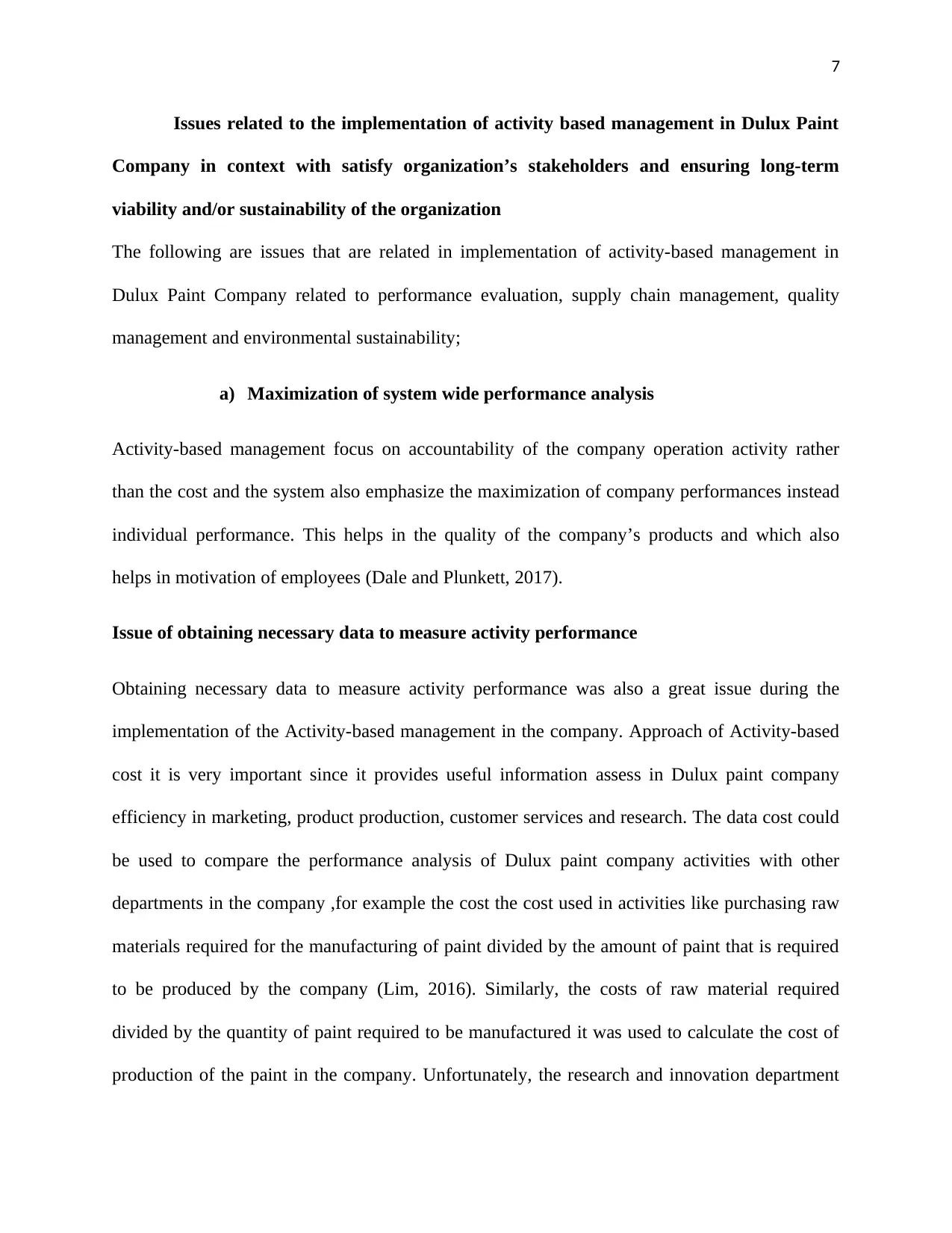
7
Issues related to the implementation of activity based management in Dulux Paint
Company in context with satisfy organization’s stakeholders and ensuring long-term
viability and/or sustainability of the organization
The following are issues that are related in implementation of activity-based management in
Dulux Paint Company related to performance evaluation, supply chain management, quality
management and environmental sustainability;
a) Maximization of system wide performance analysis
Activity-based management focus on accountability of the company operation activity rather
than the cost and the system also emphasize the maximization of company performances instead
individual performance. This helps in the quality of the company’s products and which also
helps in motivation of employees (Dale and Plunkett, 2017).
Issue of obtaining necessary data to measure activity performance
Obtaining necessary data to measure activity performance was also a great issue during the
implementation of the Activity-based management in the company. Approach of Activity-based
cost it is very important since it provides useful information assess in Dulux paint company
efficiency in marketing, product production, customer services and research. The data cost could
be used to compare the performance analysis of Dulux paint company activities with other
departments in the company ,for example the cost the cost used in activities like purchasing raw
materials required for the manufacturing of paint divided by the amount of paint that is required
to be produced by the company (Lim, 2016). Similarly, the costs of raw material required
divided by the quantity of paint required to be manufactured it was used to calculate the cost of
production of the paint in the company. Unfortunately, the research and innovation department
Issues related to the implementation of activity based management in Dulux Paint
Company in context with satisfy organization’s stakeholders and ensuring long-term
viability and/or sustainability of the organization
The following are issues that are related in implementation of activity-based management in
Dulux Paint Company related to performance evaluation, supply chain management, quality
management and environmental sustainability;
a) Maximization of system wide performance analysis
Activity-based management focus on accountability of the company operation activity rather
than the cost and the system also emphasize the maximization of company performances instead
individual performance. This helps in the quality of the company’s products and which also
helps in motivation of employees (Dale and Plunkett, 2017).
Issue of obtaining necessary data to measure activity performance
Obtaining necessary data to measure activity performance was also a great issue during the
implementation of the Activity-based management in the company. Approach of Activity-based
cost it is very important since it provides useful information assess in Dulux paint company
efficiency in marketing, product production, customer services and research. The data cost could
be used to compare the performance analysis of Dulux paint company activities with other
departments in the company ,for example the cost the cost used in activities like purchasing raw
materials required for the manufacturing of paint divided by the amount of paint that is required
to be produced by the company (Lim, 2016). Similarly, the costs of raw material required
divided by the quantity of paint required to be manufactured it was used to calculate the cost of
production of the paint in the company. Unfortunately, the research and innovation department
Paraphrase This Document
Need a fresh take? Get an instant paraphrase of this document with our AI Paraphraser
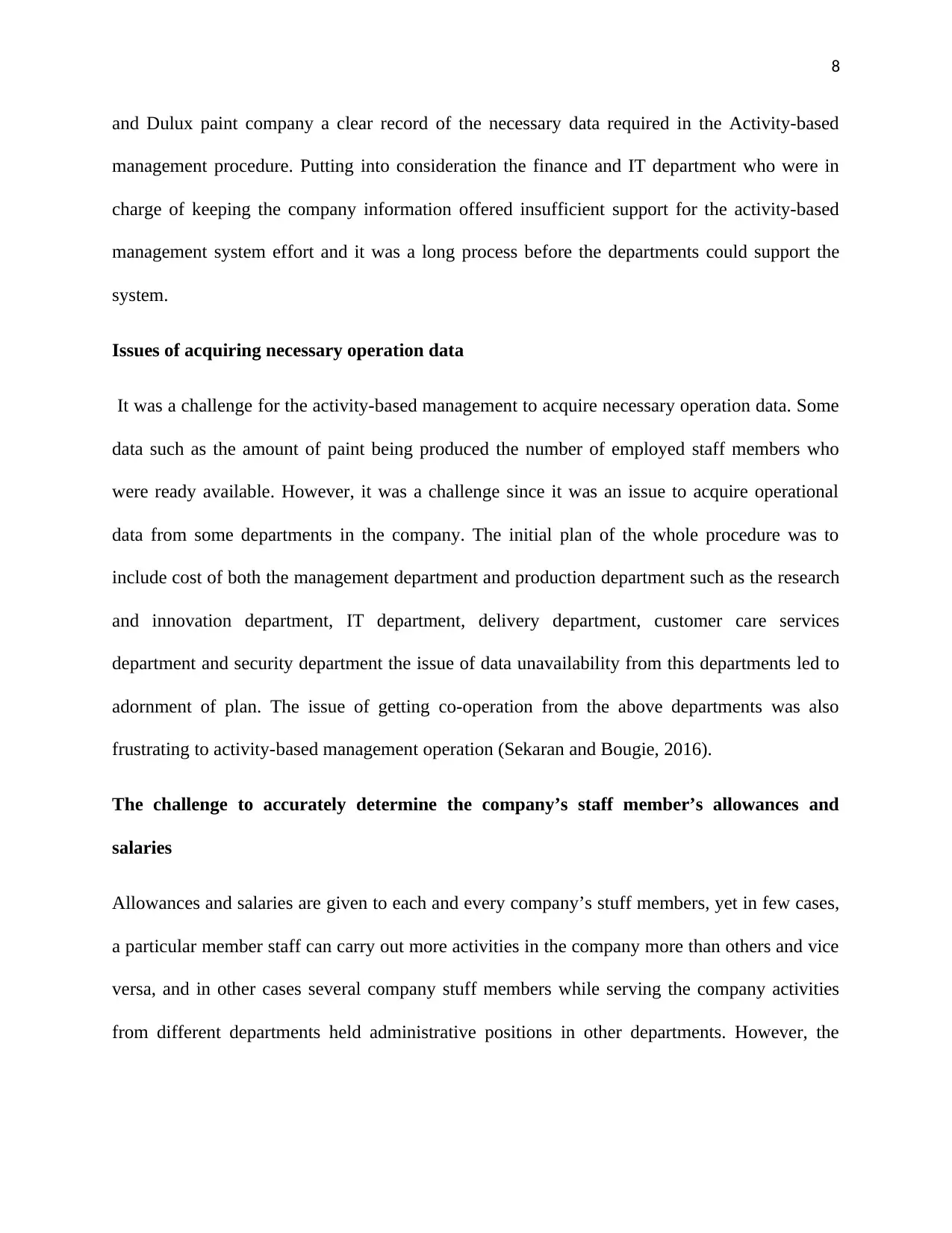
8
and Dulux paint company a clear record of the necessary data required in the Activity-based
management procedure. Putting into consideration the finance and IT department who were in
charge of keeping the company information offered insufficient support for the activity-based
management system effort and it was a long process before the departments could support the
system.
Issues of acquiring necessary operation data
It was a challenge for the activity-based management to acquire necessary operation data. Some
data such as the amount of paint being produced the number of employed staff members who
were ready available. However, it was a challenge since it was an issue to acquire operational
data from some departments in the company. The initial plan of the whole procedure was to
include cost of both the management department and production department such as the research
and innovation department, IT department, delivery department, customer care services
department and security department the issue of data unavailability from this departments led to
adornment of plan. The issue of getting co-operation from the above departments was also
frustrating to activity-based management operation (Sekaran and Bougie, 2016).
The challenge to accurately determine the company’s staff member’s allowances and
salaries
Allowances and salaries are given to each and every company’s stuff members, yet in few cases,
a particular member staff can carry out more activities in the company more than others and vice
versa, and in other cases several company stuff members while serving the company activities
from different departments held administrative positions in other departments. However, the
and Dulux paint company a clear record of the necessary data required in the Activity-based
management procedure. Putting into consideration the finance and IT department who were in
charge of keeping the company information offered insufficient support for the activity-based
management system effort and it was a long process before the departments could support the
system.
Issues of acquiring necessary operation data
It was a challenge for the activity-based management to acquire necessary operation data. Some
data such as the amount of paint being produced the number of employed staff members who
were ready available. However, it was a challenge since it was an issue to acquire operational
data from some departments in the company. The initial plan of the whole procedure was to
include cost of both the management department and production department such as the research
and innovation department, IT department, delivery department, customer care services
department and security department the issue of data unavailability from this departments led to
adornment of plan. The issue of getting co-operation from the above departments was also
frustrating to activity-based management operation (Sekaran and Bougie, 2016).
The challenge to accurately determine the company’s staff member’s allowances and
salaries
Allowances and salaries are given to each and every company’s stuff members, yet in few cases,
a particular member staff can carry out more activities in the company more than others and vice
versa, and in other cases several company stuff members while serving the company activities
from different departments held administrative positions in other departments. However, the
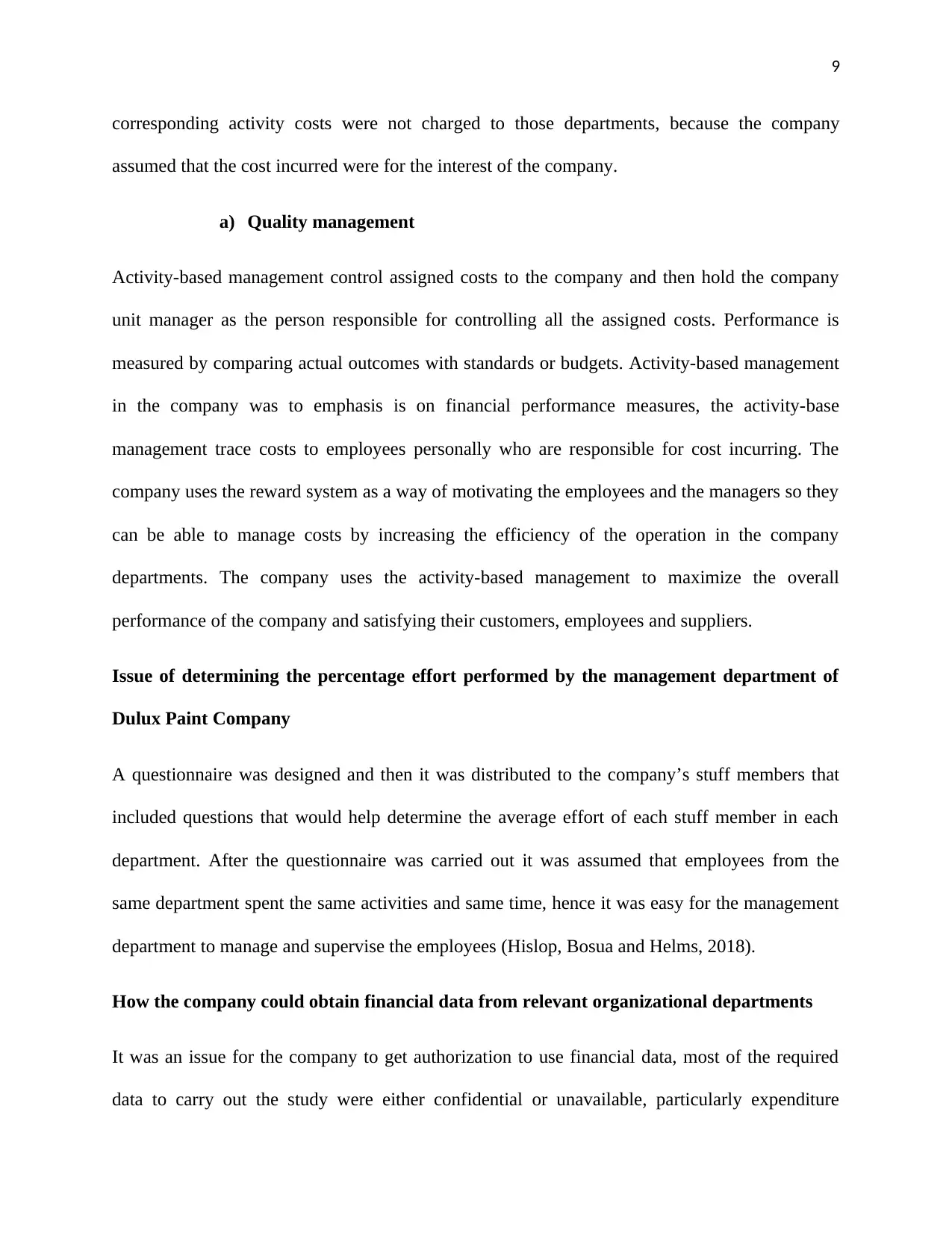
9
corresponding activity costs were not charged to those departments, because the company
assumed that the cost incurred were for the interest of the company.
a) Quality management
Activity-based management control assigned costs to the company and then hold the company
unit manager as the person responsible for controlling all the assigned costs. Performance is
measured by comparing actual outcomes with standards or budgets. Activity-based management
in the company was to emphasis is on financial performance measures, the activity-base
management trace costs to employees personally who are responsible for cost incurring. The
company uses the reward system as a way of motivating the employees and the managers so they
can be able to manage costs by increasing the efficiency of the operation in the company
departments. The company uses the activity-based management to maximize the overall
performance of the company and satisfying their customers, employees and suppliers.
Issue of determining the percentage effort performed by the management department of
Dulux Paint Company
A questionnaire was designed and then it was distributed to the company’s stuff members that
included questions that would help determine the average effort of each stuff member in each
department. After the questionnaire was carried out it was assumed that employees from the
same department spent the same activities and same time, hence it was easy for the management
department to manage and supervise the employees (Hislop, Bosua and Helms, 2018).
How the company could obtain financial data from relevant organizational departments
It was an issue for the company to get authorization to use financial data, most of the required
data to carry out the study were either confidential or unavailable, particularly expenditure
corresponding activity costs were not charged to those departments, because the company
assumed that the cost incurred were for the interest of the company.
a) Quality management
Activity-based management control assigned costs to the company and then hold the company
unit manager as the person responsible for controlling all the assigned costs. Performance is
measured by comparing actual outcomes with standards or budgets. Activity-based management
in the company was to emphasis is on financial performance measures, the activity-base
management trace costs to employees personally who are responsible for cost incurring. The
company uses the reward system as a way of motivating the employees and the managers so they
can be able to manage costs by increasing the efficiency of the operation in the company
departments. The company uses the activity-based management to maximize the overall
performance of the company and satisfying their customers, employees and suppliers.
Issue of determining the percentage effort performed by the management department of
Dulux Paint Company
A questionnaire was designed and then it was distributed to the company’s stuff members that
included questions that would help determine the average effort of each stuff member in each
department. After the questionnaire was carried out it was assumed that employees from the
same department spent the same activities and same time, hence it was easy for the management
department to manage and supervise the employees (Hislop, Bosua and Helms, 2018).
How the company could obtain financial data from relevant organizational departments
It was an issue for the company to get authorization to use financial data, most of the required
data to carry out the study were either confidential or unavailable, particularly expenditure
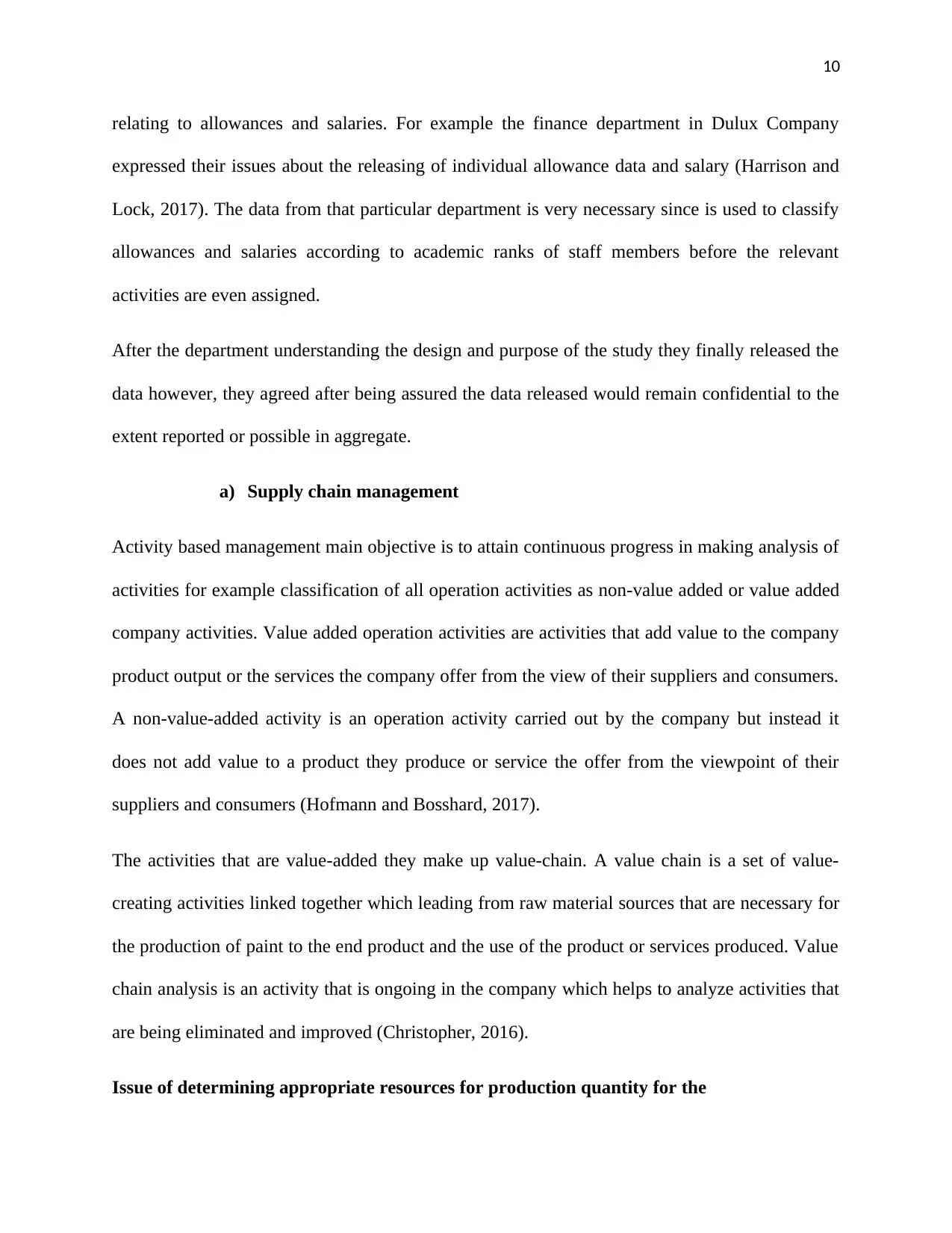
10
relating to allowances and salaries. For example the finance department in Dulux Company
expressed their issues about the releasing of individual allowance data and salary (Harrison and
Lock, 2017). The data from that particular department is very necessary since is used to classify
allowances and salaries according to academic ranks of staff members before the relevant
activities are even assigned.
After the department understanding the design and purpose of the study they finally released the
data however, they agreed after being assured the data released would remain confidential to the
extent reported or possible in aggregate.
a) Supply chain management
Activity based management main objective is to attain continuous progress in making analysis of
activities for example classification of all operation activities as non-value added or value added
company activities. Value added operation activities are activities that add value to the company
product output or the services the company offer from the view of their suppliers and consumers.
A non-value-added activity is an operation activity carried out by the company but instead it
does not add value to a product they produce or service the offer from the viewpoint of their
suppliers and consumers (Hofmann and Bosshard, 2017).
The activities that are value-added they make up value-chain. A value chain is a set of value-
creating activities linked together which leading from raw material sources that are necessary for
the production of paint to the end product and the use of the product or services produced. Value
chain analysis is an activity that is ongoing in the company which helps to analyze activities that
are being eliminated and improved (Christopher, 2016).
Issue of determining appropriate resources for production quantity for the
relating to allowances and salaries. For example the finance department in Dulux Company
expressed their issues about the releasing of individual allowance data and salary (Harrison and
Lock, 2017). The data from that particular department is very necessary since is used to classify
allowances and salaries according to academic ranks of staff members before the relevant
activities are even assigned.
After the department understanding the design and purpose of the study they finally released the
data however, they agreed after being assured the data released would remain confidential to the
extent reported or possible in aggregate.
a) Supply chain management
Activity based management main objective is to attain continuous progress in making analysis of
activities for example classification of all operation activities as non-value added or value added
company activities. Value added operation activities are activities that add value to the company
product output or the services the company offer from the view of their suppliers and consumers.
A non-value-added activity is an operation activity carried out by the company but instead it
does not add value to a product they produce or service the offer from the viewpoint of their
suppliers and consumers (Hofmann and Bosshard, 2017).
The activities that are value-added they make up value-chain. A value chain is a set of value-
creating activities linked together which leading from raw material sources that are necessary for
the production of paint to the end product and the use of the product or services produced. Value
chain analysis is an activity that is ongoing in the company which helps to analyze activities that
are being eliminated and improved (Christopher, 2016).
Issue of determining appropriate resources for production quantity for the
Secure Best Marks with AI Grader
Need help grading? Try our AI Grader for instant feedback on your assignments.
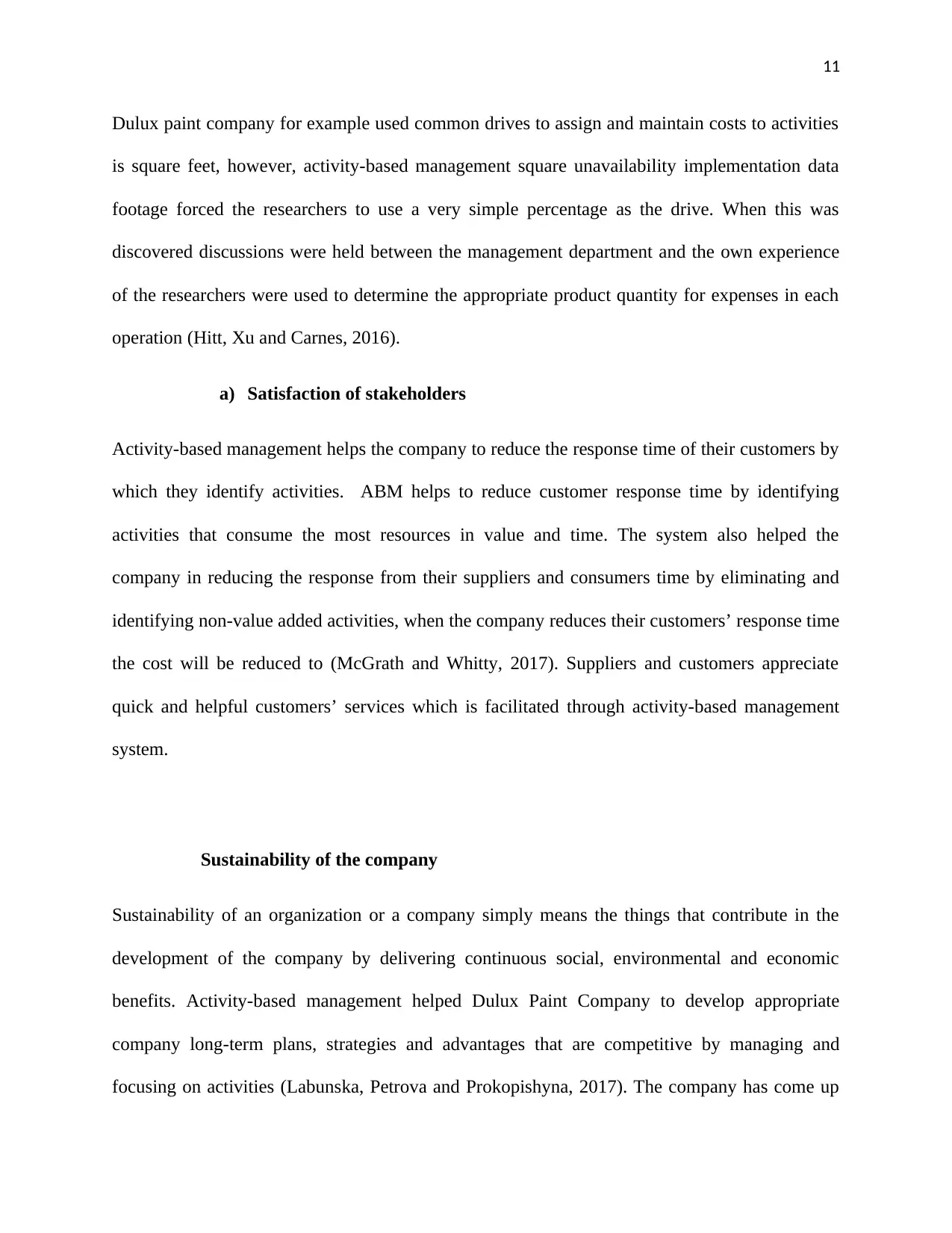
11
Dulux paint company for example used common drives to assign and maintain costs to activities
is square feet, however, activity-based management square unavailability implementation data
footage forced the researchers to use a very simple percentage as the drive. When this was
discovered discussions were held between the management department and the own experience
of the researchers were used to determine the appropriate product quantity for expenses in each
operation (Hitt, Xu and Carnes, 2016).
a) Satisfaction of stakeholders
Activity-based management helps the company to reduce the response time of their customers by
which they identify activities. ABM helps to reduce customer response time by identifying
activities that consume the most resources in value and time. The system also helped the
company in reducing the response from their suppliers and consumers time by eliminating and
identifying non-value added activities, when the company reduces their customers’ response time
the cost will be reduced to (McGrath and Whitty, 2017). Suppliers and customers appreciate
quick and helpful customers’ services which is facilitated through activity-based management
system.
Sustainability of the company
Sustainability of an organization or a company simply means the things that contribute in the
development of the company by delivering continuous social, environmental and economic
benefits. Activity-based management helped Dulux Paint Company to develop appropriate
company long-term plans, strategies and advantages that are competitive by managing and
focusing on activities (Labunska, Petrova and Prokopishyna, 2017). The company has come up
Dulux paint company for example used common drives to assign and maintain costs to activities
is square feet, however, activity-based management square unavailability implementation data
footage forced the researchers to use a very simple percentage as the drive. When this was
discovered discussions were held between the management department and the own experience
of the researchers were used to determine the appropriate product quantity for expenses in each
operation (Hitt, Xu and Carnes, 2016).
a) Satisfaction of stakeholders
Activity-based management helps the company to reduce the response time of their customers by
which they identify activities. ABM helps to reduce customer response time by identifying
activities that consume the most resources in value and time. The system also helped the
company in reducing the response from their suppliers and consumers time by eliminating and
identifying non-value added activities, when the company reduces their customers’ response time
the cost will be reduced to (McGrath and Whitty, 2017). Suppliers and customers appreciate
quick and helpful customers’ services which is facilitated through activity-based management
system.
Sustainability of the company
Sustainability of an organization or a company simply means the things that contribute in the
development of the company by delivering continuous social, environmental and economic
benefits. Activity-based management helped Dulux Paint Company to develop appropriate
company long-term plans, strategies and advantages that are competitive by managing and
focusing on activities (Labunska, Petrova and Prokopishyna, 2017). The company has come up
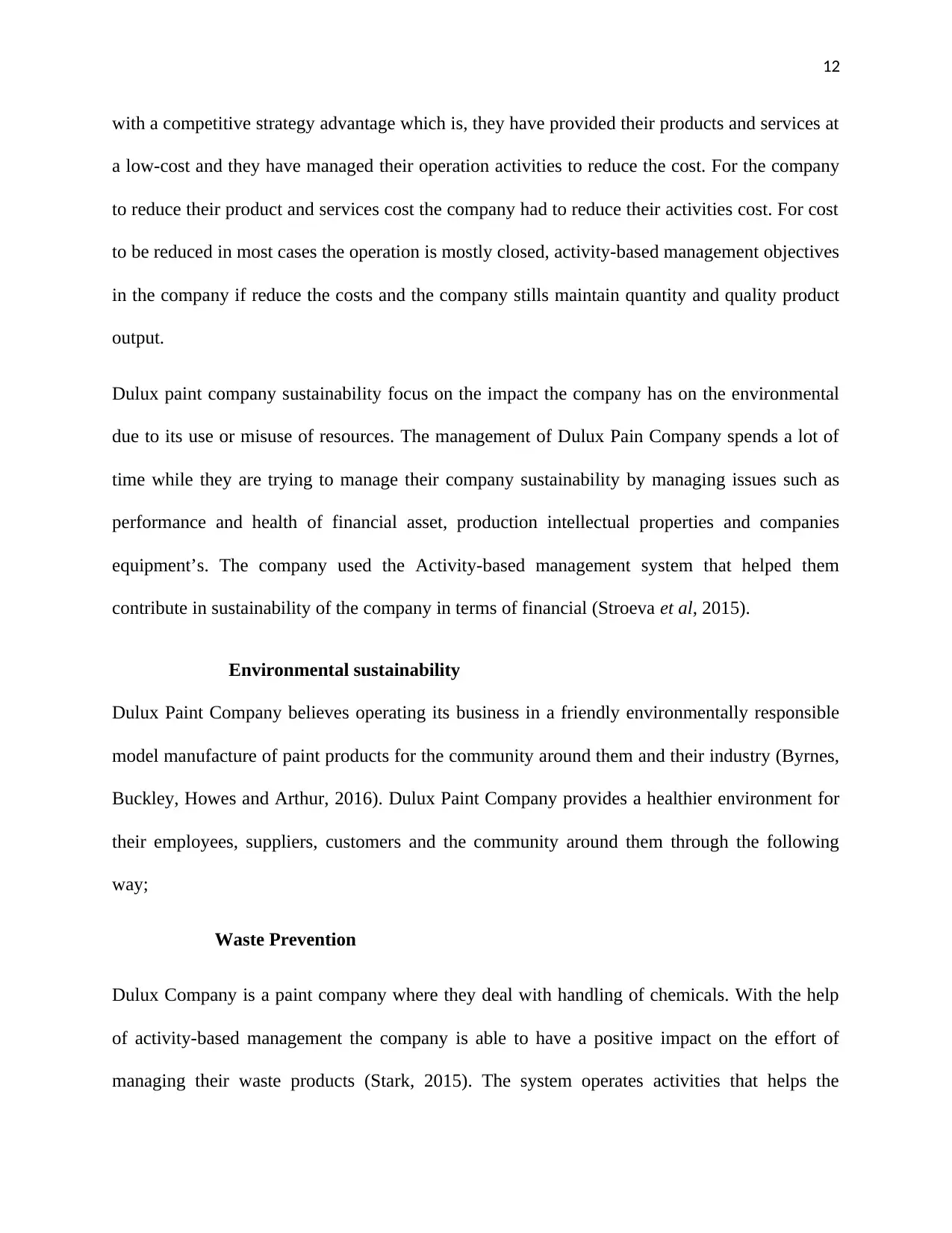
12
with a competitive strategy advantage which is, they have provided their products and services at
a low-cost and they have managed their operation activities to reduce the cost. For the company
to reduce their product and services cost the company had to reduce their activities cost. For cost
to be reduced in most cases the operation is mostly closed, activity-based management objectives
in the company if reduce the costs and the company stills maintain quantity and quality product
output.
Dulux paint company sustainability focus on the impact the company has on the environmental
due to its use or misuse of resources. The management of Dulux Pain Company spends a lot of
time while they are trying to manage their company sustainability by managing issues such as
performance and health of financial asset, production intellectual properties and companies
equipment’s. The company used the Activity-based management system that helped them
contribute in sustainability of the company in terms of financial (Stroeva et al, 2015).
Environmental sustainability
Dulux Paint Company believes operating its business in a friendly environmentally responsible
model manufacture of paint products for the community around them and their industry (Byrnes,
Buckley, Howes and Arthur, 2016). Dulux Paint Company provides a healthier environment for
their employees, suppliers, customers and the community around them through the following
way;
Waste Prevention
Dulux Company is a paint company where they deal with handling of chemicals. With the help
of activity-based management the company is able to have a positive impact on the effort of
managing their waste products (Stark, 2015). The system operates activities that helps the
with a competitive strategy advantage which is, they have provided their products and services at
a low-cost and they have managed their operation activities to reduce the cost. For the company
to reduce their product and services cost the company had to reduce their activities cost. For cost
to be reduced in most cases the operation is mostly closed, activity-based management objectives
in the company if reduce the costs and the company stills maintain quantity and quality product
output.
Dulux paint company sustainability focus on the impact the company has on the environmental
due to its use or misuse of resources. The management of Dulux Pain Company spends a lot of
time while they are trying to manage their company sustainability by managing issues such as
performance and health of financial asset, production intellectual properties and companies
equipment’s. The company used the Activity-based management system that helped them
contribute in sustainability of the company in terms of financial (Stroeva et al, 2015).
Environmental sustainability
Dulux Paint Company believes operating its business in a friendly environmentally responsible
model manufacture of paint products for the community around them and their industry (Byrnes,
Buckley, Howes and Arthur, 2016). Dulux Paint Company provides a healthier environment for
their employees, suppliers, customers and the community around them through the following
way;
Waste Prevention
Dulux Company is a paint company where they deal with handling of chemicals. With the help
of activity-based management the company is able to have a positive impact on the effort of
managing their waste products (Stark, 2015). The system operates activities that helps the
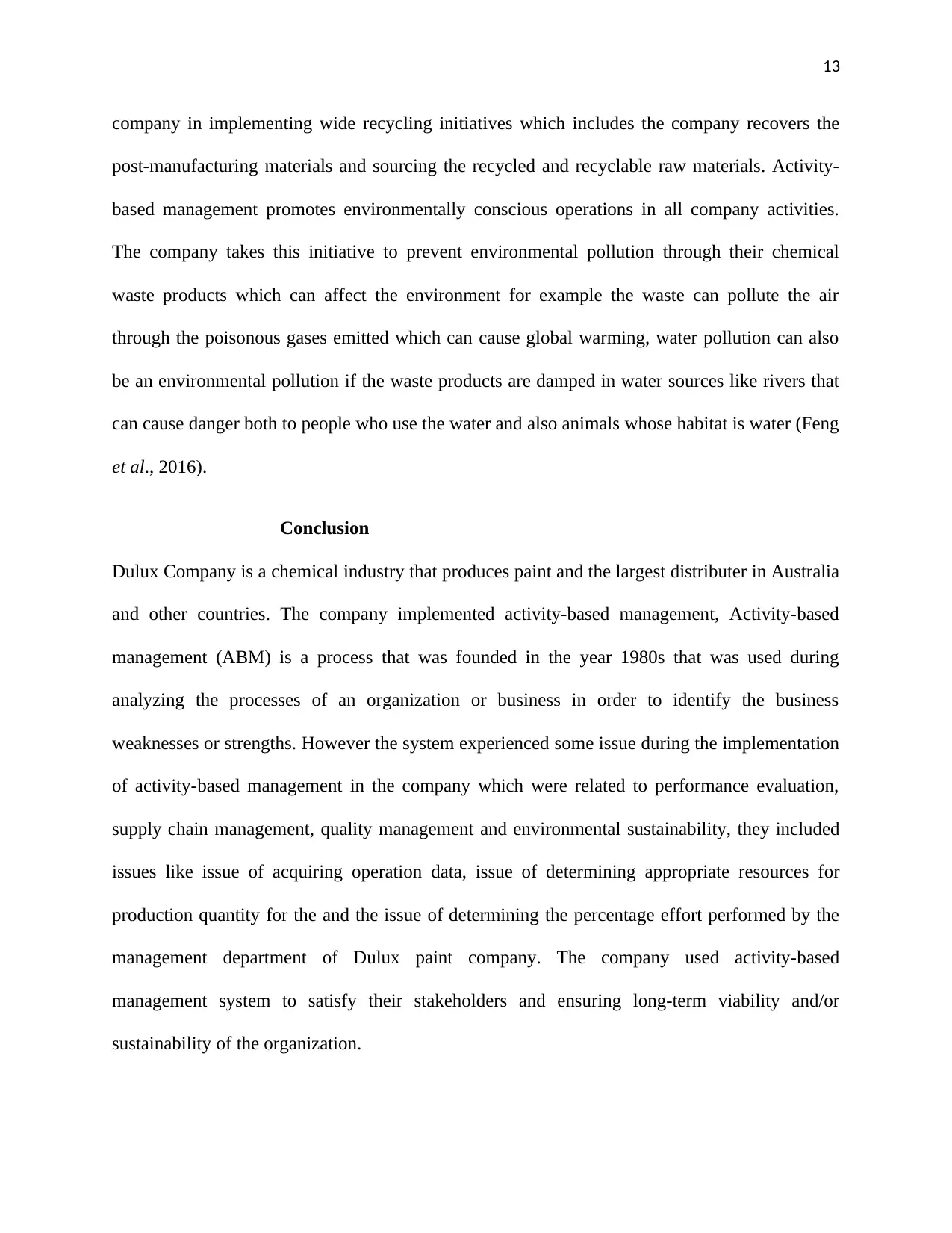
13
company in implementing wide recycling initiatives which includes the company recovers the
post-manufacturing materials and sourcing the recycled and recyclable raw materials. Activity-
based management promotes environmentally conscious operations in all company activities.
The company takes this initiative to prevent environmental pollution through their chemical
waste products which can affect the environment for example the waste can pollute the air
through the poisonous gases emitted which can cause global warming, water pollution can also
be an environmental pollution if the waste products are damped in water sources like rivers that
can cause danger both to people who use the water and also animals whose habitat is water (Feng
et al., 2016).
Conclusion
Dulux Company is a chemical industry that produces paint and the largest distributer in Australia
and other countries. The company implemented activity-based management, Activity-based
management (ABM) is a process that was founded in the year 1980s that was used during
analyzing the processes of an organization or business in order to identify the business
weaknesses or strengths. However the system experienced some issue during the implementation
of activity-based management in the company which were related to performance evaluation,
supply chain management, quality management and environmental sustainability, they included
issues like issue of acquiring operation data, issue of determining appropriate resources for
production quantity for the and the issue of determining the percentage effort performed by the
management department of Dulux paint company. The company used activity-based
management system to satisfy their stakeholders and ensuring long-term viability and/or
sustainability of the organization.
company in implementing wide recycling initiatives which includes the company recovers the
post-manufacturing materials and sourcing the recycled and recyclable raw materials. Activity-
based management promotes environmentally conscious operations in all company activities.
The company takes this initiative to prevent environmental pollution through their chemical
waste products which can affect the environment for example the waste can pollute the air
through the poisonous gases emitted which can cause global warming, water pollution can also
be an environmental pollution if the waste products are damped in water sources like rivers that
can cause danger both to people who use the water and also animals whose habitat is water (Feng
et al., 2016).
Conclusion
Dulux Company is a chemical industry that produces paint and the largest distributer in Australia
and other countries. The company implemented activity-based management, Activity-based
management (ABM) is a process that was founded in the year 1980s that was used during
analyzing the processes of an organization or business in order to identify the business
weaknesses or strengths. However the system experienced some issue during the implementation
of activity-based management in the company which were related to performance evaluation,
supply chain management, quality management and environmental sustainability, they included
issues like issue of acquiring operation data, issue of determining appropriate resources for
production quantity for the and the issue of determining the percentage effort performed by the
management department of Dulux paint company. The company used activity-based
management system to satisfy their stakeholders and ensuring long-term viability and/or
sustainability of the organization.
Paraphrase This Document
Need a fresh take? Get an instant paraphrase of this document with our AI Paraphraser
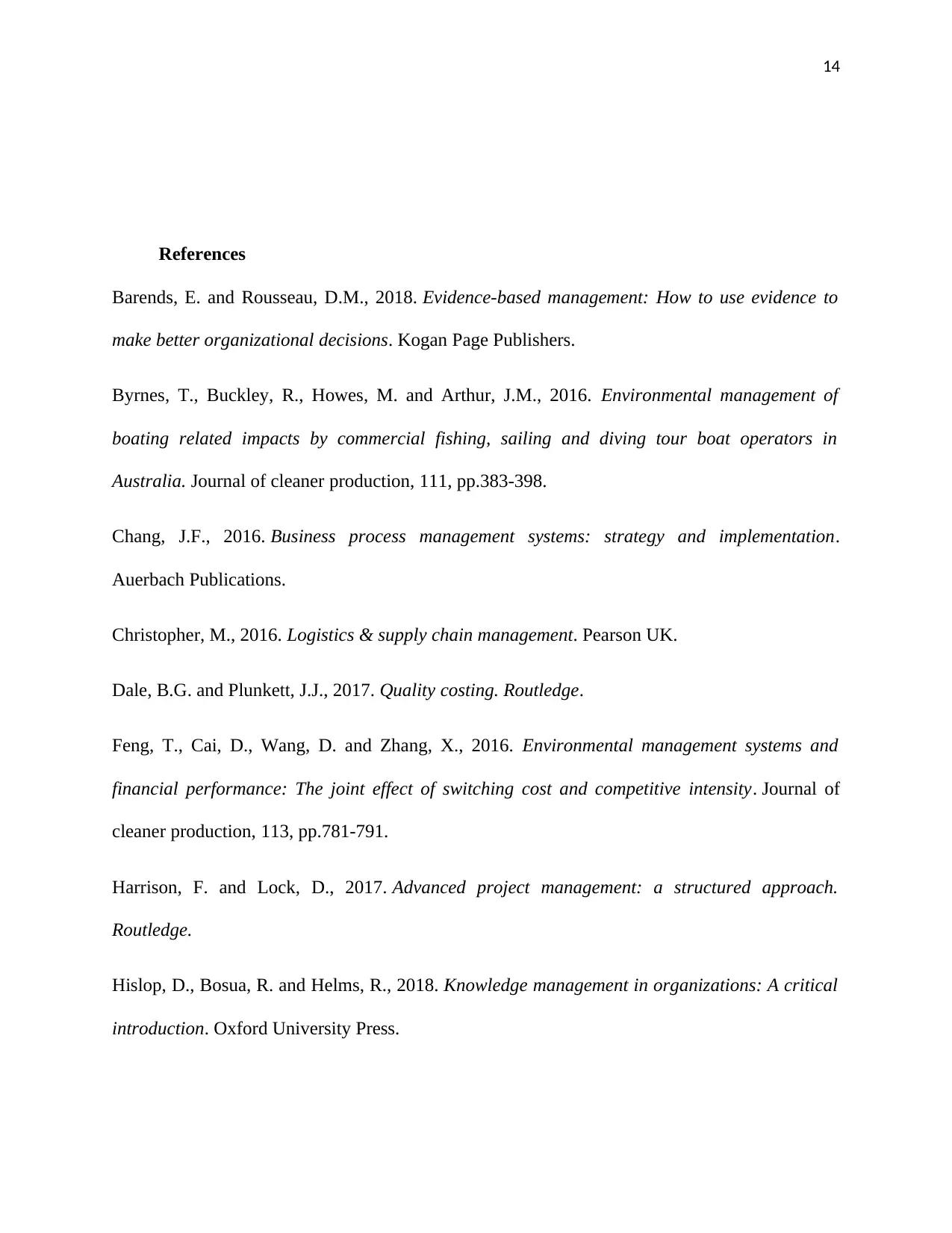
14
References
Barends, E. and Rousseau, D.M., 2018. Evidence-based management: How to use evidence to
make better organizational decisions. Kogan Page Publishers.
Byrnes, T., Buckley, R., Howes, M. and Arthur, J.M., 2016. Environmental management of
boating related impacts by commercial fishing, sailing and diving tour boat operators in
Australia. Journal of cleaner production, 111, pp.383-398.
Chang, J.F., 2016. Business process management systems: strategy and implementation.
Auerbach Publications.
Christopher, M., 2016. Logistics & supply chain management. Pearson UK.
Dale, B.G. and Plunkett, J.J., 2017. Quality costing. Routledge.
Feng, T., Cai, D., Wang, D. and Zhang, X., 2016. Environmental management systems and
financial performance: The joint effect of switching cost and competitive intensity. Journal of
cleaner production, 113, pp.781-791.
Harrison, F. and Lock, D., 2017. Advanced project management: a structured approach.
Routledge.
Hislop, D., Bosua, R. and Helms, R., 2018. Knowledge management in organizations: A critical
introduction. Oxford University Press.
References
Barends, E. and Rousseau, D.M., 2018. Evidence-based management: How to use evidence to
make better organizational decisions. Kogan Page Publishers.
Byrnes, T., Buckley, R., Howes, M. and Arthur, J.M., 2016. Environmental management of
boating related impacts by commercial fishing, sailing and diving tour boat operators in
Australia. Journal of cleaner production, 111, pp.383-398.
Chang, J.F., 2016. Business process management systems: strategy and implementation.
Auerbach Publications.
Christopher, M., 2016. Logistics & supply chain management. Pearson UK.
Dale, B.G. and Plunkett, J.J., 2017. Quality costing. Routledge.
Feng, T., Cai, D., Wang, D. and Zhang, X., 2016. Environmental management systems and
financial performance: The joint effect of switching cost and competitive intensity. Journal of
cleaner production, 113, pp.781-791.
Harrison, F. and Lock, D., 2017. Advanced project management: a structured approach.
Routledge.
Hislop, D., Bosua, R. and Helms, R., 2018. Knowledge management in organizations: A critical
introduction. Oxford University Press.
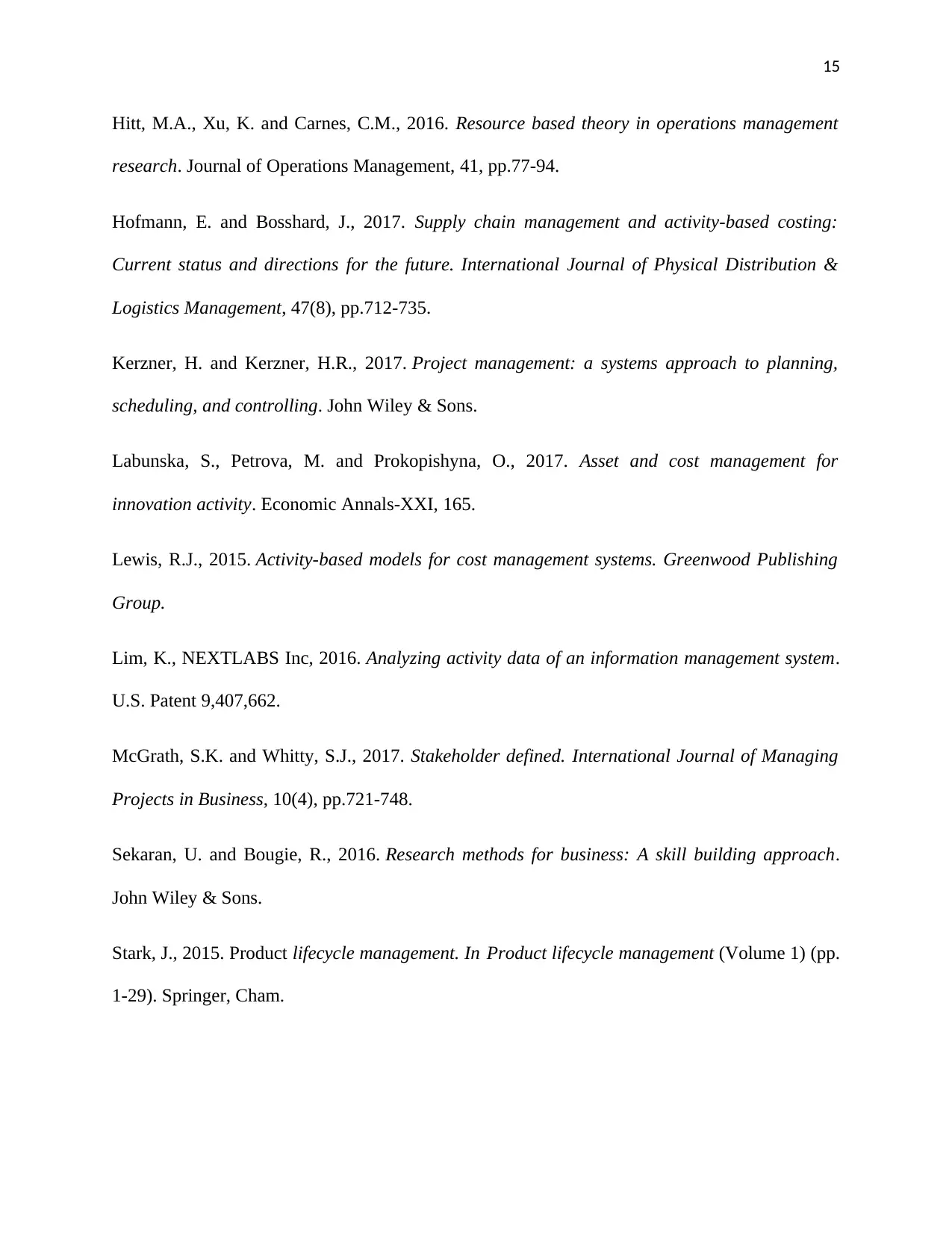
15
Hitt, M.A., Xu, K. and Carnes, C.M., 2016. Resource based theory in operations management
research. Journal of Operations Management, 41, pp.77-94.
Hofmann, E. and Bosshard, J., 2017. Supply chain management and activity-based costing:
Current status and directions for the future. International Journal of Physical Distribution &
Logistics Management, 47(8), pp.712-735.
Kerzner, H. and Kerzner, H.R., 2017. Project management: a systems approach to planning,
scheduling, and controlling. John Wiley & Sons.
Labunska, S., Petrova, M. and Prokopishyna, O., 2017. Asset and cost management for
innovation activity. Economic Annals-XXI, 165.
Lewis, R.J., 2015. Activity-based models for cost management systems. Greenwood Publishing
Group.
Lim, K., NEXTLABS Inc, 2016. Analyzing activity data of an information management system.
U.S. Patent 9,407,662.
McGrath, S.K. and Whitty, S.J., 2017. Stakeholder defined. International Journal of Managing
Projects in Business, 10(4), pp.721-748.
Sekaran, U. and Bougie, R., 2016. Research methods for business: A skill building approach.
John Wiley & Sons.
Stark, J., 2015. Product lifecycle management. In Product lifecycle management (Volume 1) (pp.
1-29). Springer, Cham.
Hitt, M.A., Xu, K. and Carnes, C.M., 2016. Resource based theory in operations management
research. Journal of Operations Management, 41, pp.77-94.
Hofmann, E. and Bosshard, J., 2017. Supply chain management and activity-based costing:
Current status and directions for the future. International Journal of Physical Distribution &
Logistics Management, 47(8), pp.712-735.
Kerzner, H. and Kerzner, H.R., 2017. Project management: a systems approach to planning,
scheduling, and controlling. John Wiley & Sons.
Labunska, S., Petrova, M. and Prokopishyna, O., 2017. Asset and cost management for
innovation activity. Economic Annals-XXI, 165.
Lewis, R.J., 2015. Activity-based models for cost management systems. Greenwood Publishing
Group.
Lim, K., NEXTLABS Inc, 2016. Analyzing activity data of an information management system.
U.S. Patent 9,407,662.
McGrath, S.K. and Whitty, S.J., 2017. Stakeholder defined. International Journal of Managing
Projects in Business, 10(4), pp.721-748.
Sekaran, U. and Bougie, R., 2016. Research methods for business: A skill building approach.
John Wiley & Sons.
Stark, J., 2015. Product lifecycle management. In Product lifecycle management (Volume 1) (pp.
1-29). Springer, Cham.
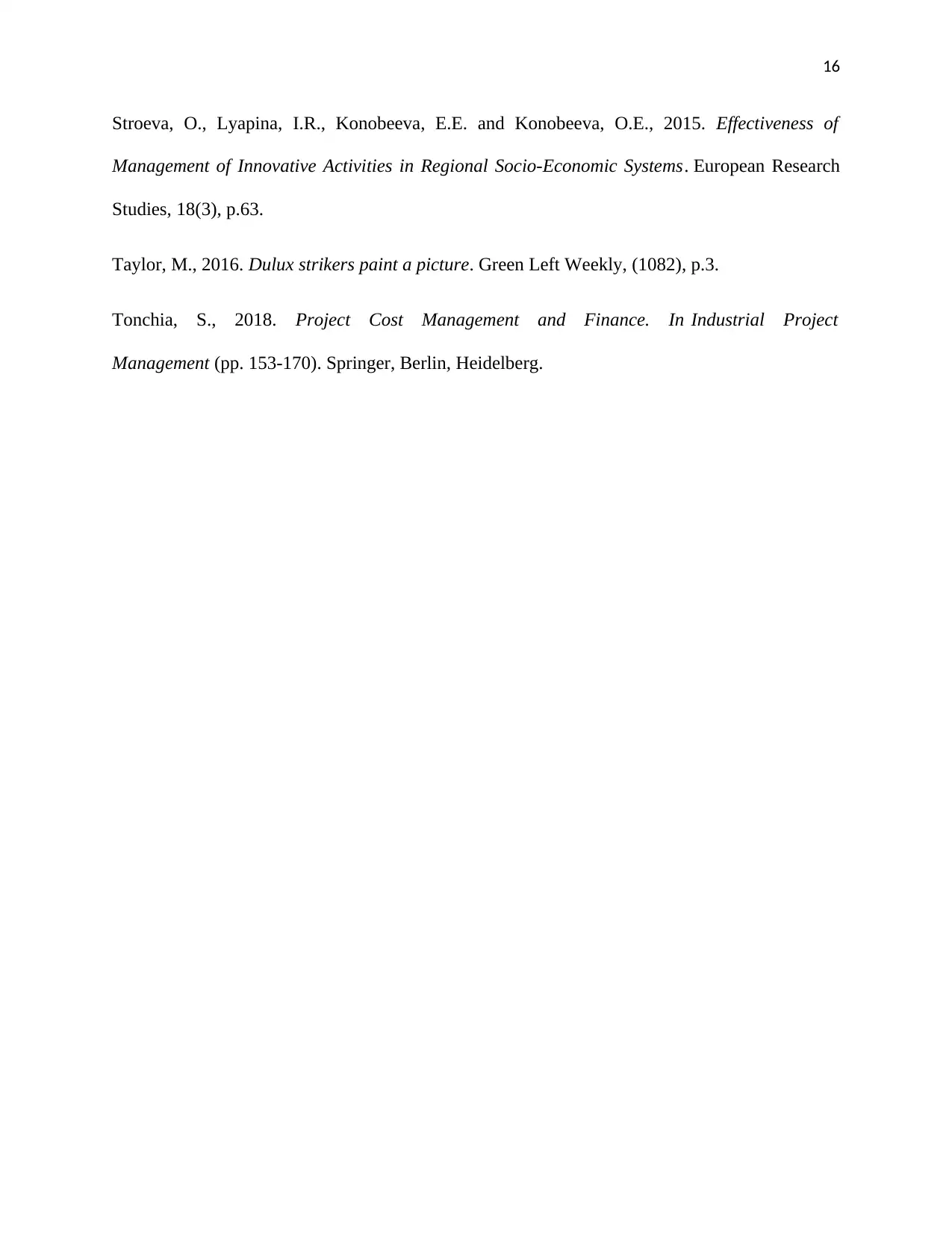
16
Stroeva, O., Lyapina, I.R., Konobeeva, E.E. and Konobeeva, O.E., 2015. Effectiveness of
Management of Innovative Activities in Regional Socio-Economic Systems. European Research
Studies, 18(3), p.63.
Taylor, M., 2016. Dulux strikers paint a picture. Green Left Weekly, (1082), p.3.
Tonchia, S., 2018. Project Cost Management and Finance. In Industrial Project
Management (pp. 153-170). Springer, Berlin, Heidelberg.
Stroeva, O., Lyapina, I.R., Konobeeva, E.E. and Konobeeva, O.E., 2015. Effectiveness of
Management of Innovative Activities in Regional Socio-Economic Systems. European Research
Studies, 18(3), p.63.
Taylor, M., 2016. Dulux strikers paint a picture. Green Left Weekly, (1082), p.3.
Tonchia, S., 2018. Project Cost Management and Finance. In Industrial Project
Management (pp. 153-170). Springer, Berlin, Heidelberg.
1 out of 16
Related Documents
Your All-in-One AI-Powered Toolkit for Academic Success.
+13062052269
info@desklib.com
Available 24*7 on WhatsApp / Email
![[object Object]](/_next/static/media/star-bottom.7253800d.svg)
Unlock your academic potential
© 2024 | Zucol Services PVT LTD | All rights reserved.





